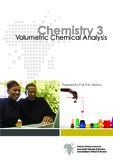| dc.contributor.author | Shiundu, Paul M | |
| dc.date.accessioned | 2015-06-14T07:47:36Z | |
| dc.date.available | 2015-06-14T07:47:36Z | |
| dc.date.issued | 2010 | |
| dc.identifier.citation | Chemistry 3 Volumetric Chemical Analysis | en_US |
| dc.identifier.uri | http://oer.avu.org/handle/123456789/52 | |
| dc.identifier.uri | http://hdl.handle.net/11295/84756 | |
| dc.description.abstract | Chemists generally use standardized symbols and equations for recording their
measurements and observations. Most of the data that we obtain in the subject of
chemistry may be qualitative or quantitative or both qualitative and quantitative.
This module will be concerned with the tools and techniques of quantitative chemical
analysis. In quantitative measurements and analyses, there is always some
degree of uncertainity associated with the various measurements made. Knowing
how to determine this uncertainty is just as important as knowing the final result
of the analysis. This is because having data that is so uncertain as to be useless is
no better than having no data at all. A unit of this module will deal with the ways
of minimizing any uncertainty in quantitative measurements. Other analytical
techniques and the principles which underpin them to be studied in this module
include titration. Titration is based on the measurement of concentrations of
substances, which affords the chemist the opportunity to undertake quantitative
study of reactants and products in a chemical reaction. This study is known as
stoichiometry of a reaction. | en_US |
| dc.language.iso | en | en_US |
| dc.title | Chemistry 3 Volumetric Chemical Analysis | en_US |
| dc.type | Book | en_US |
| dc.type.material | en_US | en_US |

